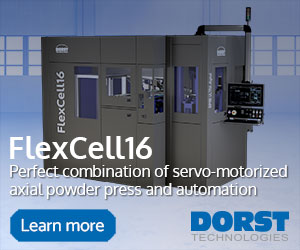POWDERMET2015: North American automotive trends
June 10, 2015
In his state of the PM industry presentation at POWDERMET2015, San Diego, USA, May 18 2015, Richard Pfingstler, President of the Metal Powder Industries Federation, cautioned that whilst there is a positive growth outlook for PM in 2015, with a potential 17.3 million car-year market, certain headwinds might diminish the pace of this growth.
“As we reflect on 2004, when iron powder shipments hit a record 473,804 short tons, we note that North American light-vehicle production was 16.2 million units. In 2014, auto builds advanced to 16.8 million units but iron powder shipments reached only 416,373 short tons. A disconnect appears,” stated Pfingstler.
“Several explanations suggest themselves. There is a new paradigm for light-weighting in the automotive industry. Consider the example of the new 2015 Ford F-150 truck, which comes in at a weight of some 700 pounds less than the comparable 2014 model; light-weight components such as its aluminum body panels and high-strength steel ladder-frames come straight from technologies used in the aerospace industry.”
“The trend spawned by manufacturers’ quest for higher CAFE numbers is toward smaller powertrains, from eight to six and four-cylinder engines, and thus toward fewer and lighter-weight parts – and away from heavy PM bearing caps and powder-forged connecting rods. PM, however, is not alone in feeling this impact: competitive technologies such as castings, wrought forgings, and machined parts must also pony up to meet rising technological requirements.”
Pfingstler stated that MPIF recognises this light-weighting trend as an opportunity. As such, MPIF has joined the Lightweight Innovations for Tomorrow (LIFT), an industry-led, government-funded consortium, to help facilitate technology transfer into supply-chain companies. LIFT is one of the institutes launched by the National Network for Manufacturing Innovation. MPIF’s move to gain a voice in this $140+ million dollar program is important for our industry.
Another possible explanation for the disconnect between the increased auto builds and the failure of powder shipments to rise to previous levels is that many new engines and transmissions are being designed in Europe and Asia with less PM content. The number of possible PM applications has decreased. “It is said European auto engineers lean towards higher performance over cost and toward closer tolerances. For example, in North America a Class 8 gear is normally acceptable, while European engineers require Class 9 and 10 gears. Meanwhile, a leading German automatic transmission supplier has designed an eight-nine speed transmission for a ‘Detroit 3’ auto maker that contains only two PM oil-pump parts,” explained Pfingstler.
“This trend has had the effect of forcing U.S. parts makers to meet tighter or “Europeanized” tolerance requirements of less than 10 microns across the board. Go to trends for meeting these demands include surface finish grinding, localised hardening, grinding after heat treating, and grinding or machining for flatness,” commented Pfingstler.
“Focusing on distinct PM product sectors with more value-added operations is another trend involving big name PM auto parts makers. For one specialised automotive parts supplier, adding value through extra machining and other specialised post-processing is enabling the company to book business into 2020; the company is already in discussions about designs for the 2021 model year.”
PM content in light trucks amounts to between 55 and 60 pounds, with the average PM content in light vehicles estimated at 45 pounds. This is in marked contrast with the average European vehicle, which in 2014 contained an estimated 21 pounds of PM parts.
The Metal Injection Moulding (MIM) industry has begun selling into the automotive market in North America, following the trend in Europe towards the adoption of MIM automotive components. “Automotive engineers are designing more MIM parts, which points to significant potential growth as MIM becomes more accepted. MIM parts are being designed for engines, electrical systems, and chassis hardware,” concluded Pfingstler.
Subscribe to our FREE e-newsletter
Register to receive our FREE e-newsletter and a complimentary digital subscription to Powder Metallurgy Review magazine.
Useful links: Download PM Review magazine | News headlines | Browse articles















